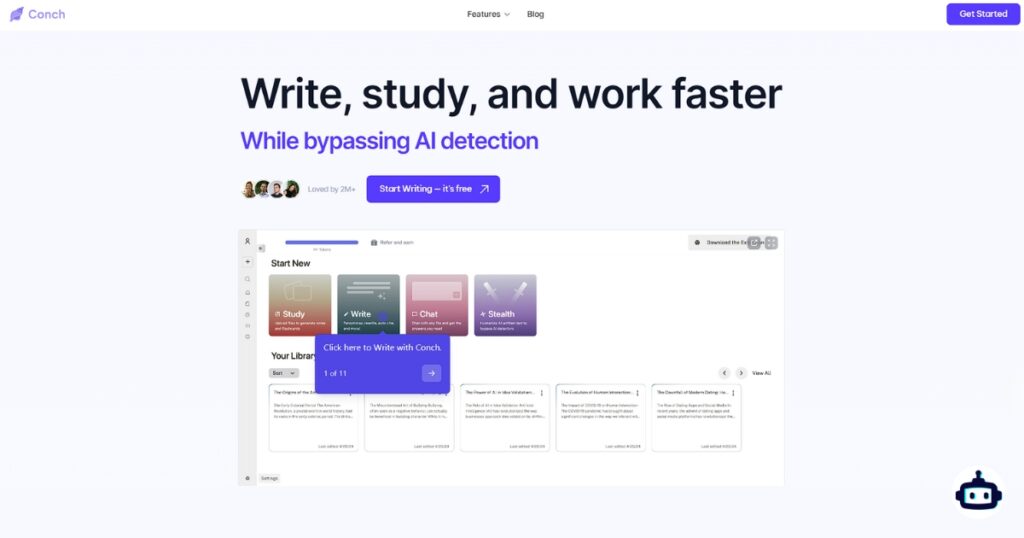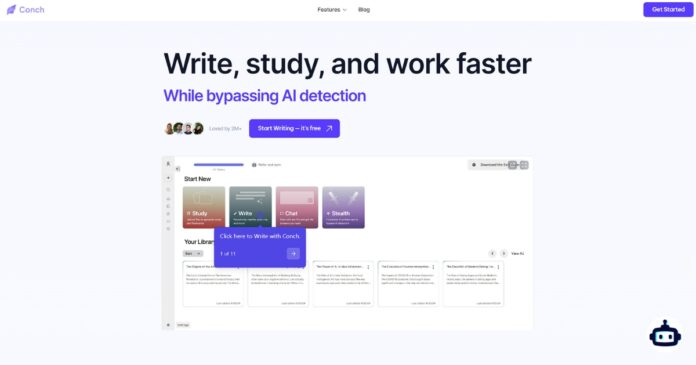
In today’s digital age, Artificial Intelligence (AI) has not only revolutionized how we live but also how we work, learn, and even entertain ourselves. One of the fascinating tools making waves in the AI world is the Conch AI Detector.
This tool is designed to detect AI-generated content, and it’s a must-have for anyone keen on maintaining content integrity and authenticity. Whether you are a writer, educator, or just a curious tech enthusiast, this guide will walk you through everything you need to know about the Conch AI Detector.
What is the Conch AI Detector?
Imagine you’re a detective, but instead of solving crimes, you’re solving the mystery of whether a piece of content was crafted by a human or a machine. The Conch AI Detector is your trusty magnifying glass in this scenario. It’s an advanced tool that uses sophisticated algorithms to analyze and determine if the content was generated by AI.
This tool is particularly valuable in educational settings where originality is paramount, in the publishing industry to maintain editorial standards, and even in legal scenarios where the authenticity of documents is crucial.
Why Use the Conch AI Detector?
1. Maintaining Content Authenticity
- The internet is flooded with content. Some of it is original, while a significant chunk is AI-generated. The Conch AI Detector helps in distinguishing the wheat from the chaff, ensuring that you are getting authentic, human-created content.
2. Educational Integrity
- For educators, ensuring that students submit original work is crucial. The Conch AI Detector can be used to check assignments and research papers, ensuring students are not passing off AI-generated content as their own.
3. Editorial Standards
- In journalism and publishing, maintaining high editorial standards is key. The Conch AI Detector helps editors verify that articles and books are written by actual authors, maintaining the credibility of the publication.
4. Legal Authenticity
- In legal settings, the authenticity of documents can make or break a case. The Conch AI Detector ensures that legal documents are genuine and not AI-generated, preserving the integrity of legal proceedings.
Step-by-Step Guide to Using the Conch AI Detector
Now that we’ve covered the why, let’s get into the how. Here’s your step-by-step guide to using the Conch AI Detector.
Step 1: Visit the Conch AI Detector Website
First things first, head over to the Conch AI Detector website. You’ll be greeted by a sleek, user-friendly interface that’s as inviting as a warm cup of cocoa on a cold day.
Step 2: Sign Up or Log In
If you’re new to Conch, you’ll need to sign up. It’s a quick and painless process—much easier than remembering where you left your keys. If you’re a returning user, just log in. Easy peasy!
Step 3: Upload or Paste Your Text
Once you’re in, you’ll see an option to upload a file or paste your text directly. Choose whichever method suits you best. Got a suspicious-looking essay? Paste it right in. Have a file full of questionable content? Upload away!
Step 4: Let the Magic Happen
Hit that “Analyze” button and let the Conch AI Detector work its magic. In moments, it’ll scan your text with the thoroughness of a detective on their fifth cup of coffee.
Step 5: Review the Results
In the blink of an eye, your results are ready. The Conch AI Detector will provide a detailed report on whether your content is AI-generated. It’s like having a miniature Sherlock Holmes in your pocket, minus the Victorian attire.
How Does the Conch AI Detector Work?
The Conch AI Detector operates through a series of complex algorithms that analyze text for patterns typical of AI-generated content. Here’s a simplified step-by-step breakdown of how it works:
Step 1: Text Input
- You start by inputting the text you want to analyze into the Conch AI Detector. This can be done by either copying and pasting the text or uploading a document.
Step 2: Initial Analysis
- The tool then performs an initial scan of the text, looking for specific markers and patterns that are often present in AI-generated content. This includes checking for repetitive phrases, unnatural sentence structures, and overuse of certain vocabulary.
Step 3: Algorithmic Processing
- Next, the Conch AI Detector runs the text through a series of algorithms. These algorithms are trained on vast datasets of both human-written and AI-generated content. They compare the input text against these datasets to identify subtle nuances and stylistic elements unique to AI-generated content.
Step 4: Result Generation
- After processing, the tool generates a report detailing the likelihood of the content being AI-generated. This report includes a confidence score, highlighting how certain the tool is about its analysis.
Step 5: Review and Action
- Finally, you review the report and decide on the necessary action. If the content is flagged as AI-generated, you might want to verify its source or ask for a human-written version.
Using the Conch AI Detector: A Practical Guide
Let’s dive into a practical example of using the Conch AI Detector. Suppose you’re an editor at a publishing house, and you’ve just received a manuscript for review. Here’s how you’d use the Conch AI Detector:
Step 1: Upload the Manuscript
- First, upload the manuscript to the Conch AI Detector platform. Ensure the document is in a compatible format, such as a Word document or a PDF.
Step 2: Initiate the Scan
- Click on the ‘Scan’ button to start the analysis. The tool will take a few moments to process the document, depending on its length.
Step 3: Review the Report
- Once the scan is complete, review the detailed report generated by the tool. Look at the confidence score and any highlighted sections that the tool flagged as potentially AI-generated.
Step 4: Take Appropriate Action
- Based on the report, decide on the next steps. If the manuscript has a high likelihood of being AI-generated, you may choose to discuss this with the author or request further revisions to ensure originality.
Tips and Tricks for Effective Use
To get the most out of the Conch.AI Detector, consider these tips and tricks:
1. Regular Updates
- Ensure you are using the latest version of the Conch.AI Detector. AI detection technology is constantly evolving, and regular updates will provide the most accurate results.
2. Combine with Human Review
- While the Conch.AI Detector is highly effective, it’s always good to combine its results with a human review. A second pair of eyes can provide additional context and insight.
3. Use for Various Content Types
- Don’t limit the use of the Conch.AI Detector to just written documents. It can be used for blog posts, social media content, and even code snippets to ensure authenticity across different content types.
4. Educate Your Team
- If you’re in a professional setting, educate your team about the importance of content authenticity and how to effectively use the Conch.AI Detector. This will ensure everyone is on the same page and utilizing the tool to its full potential.
Conclusion
The Conch AI Detector is a powerful ally in the quest for content authenticity. Whether you’re an educator, editor, or legal professional, this tool can help you maintain high standards and ensure the integrity of your content. With its advanced algorithms and user-friendly interface, the Conch AI Detector is a must-have in the modern digital toolkit.
So, the next time you’re faced with the mystery of whether a piece of content was crafted by a human or a machine, remember to bring out your trusty magnifying glass—the Conch AI Detector. It’s not just a tool; it’s your digital Sherlock Holmes, ready to crack the case and keep your content genuine. And who knows, maybe one day we’ll have AI detectors detecting AI detectors, but let’s cross that bridge when we get to it!
Frequently Asked Questions (FAQ’s)
-
Is the Conch AI Detector 100% accurate?
While no tool is perfect, the Conch AI Detector boasts impressive accuracy. It’s continually updated to improve its detection capabilities.
-
Can it detect all forms of AI-generated content?
The Conch AI Detector is designed to detect most AI-generated content, but it’s always good to use multiple tools for thorough verification.
-
How often should I use the Conch AI Detector?
It depends on your needs. Frequent content publishers might use it daily, while occasional users might check content monthly.
-
What is the Conch AI Detector?
The Conch AI Detector is an advanced tool that uses sophisticated algorithms to identify if a piece of content has been generated by artificial intelligence, helping to maintain content authenticity and integrity.
-
Can the Conch AI Detector be used for all types of content?
Yes, the Conch.AI Detector can be used for various types of content, including written documents, blog posts, social media content, and even code snippets, ensuring authenticity across different content types.
-
Is the Conch AI Detector accurate?
The Conch AI Detector is highly accurate due to its advanced algorithms and large datasets of both human-written and AI-generated content. However, combining its results with a human review is always recommended for the best outcome.
-
Do I need to update the Conch AI Detector regularly?
Yes, regular updates are important to ensure you are using the latest version of the Conch AI Detector. This will provide the most accurate results as AI detection technology is continuously evolving.

